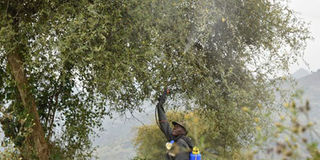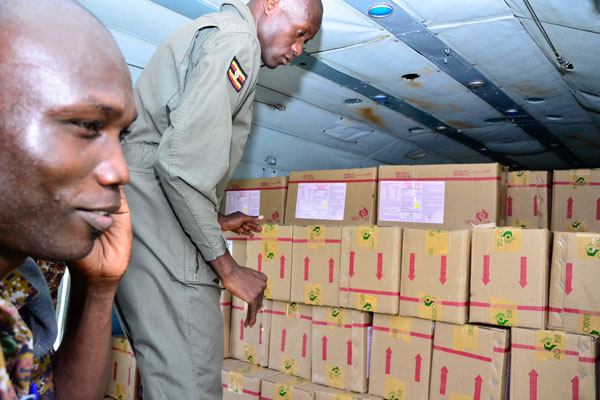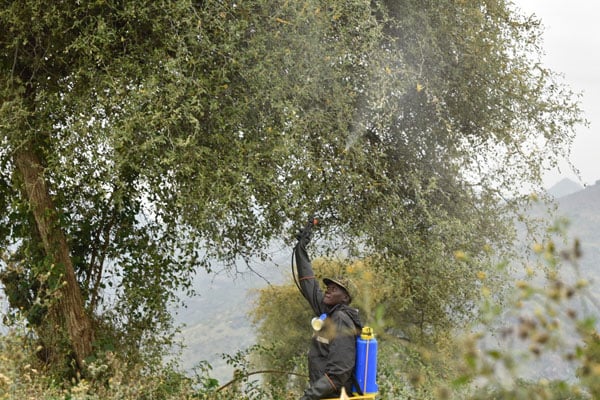Locust invasion: Uganda procures Shs2.8b insecticides for aerial spraying

Spraying. A Uganda People’s Defence Force officer sprays locusts on a tree in Nakapiripirit District. PHOTO BY LEONARD MUKOOLI
What you need to know:
- The locusts have spread to 17 districts including Abim, Kaabong, Nakapiripirit, Amudat, Agago, Katakwi, Nabilatuk, Moroto, Kitgum, Soroti and Kole among others.
Government has procured 10,000 litres of Fenitrothion, a phosphorothioate insecticide that is inexpensive and widely used worldwide, for aerial spraying against locusts.
The insecticides will reach Uganda on Friday from Japan, according to officials at Ministry of agriculture.
State Minister for Animal Husbandry, Mr Bright Rwamirama said it was a great struggle to get the pesticide.
“We have procured the chemical and it will be in the country in three days. Food and Agriculture Organisation (FAO) has offered us free transport to airlift the pesticides from Nairobi to Soroti,” Mr Rwamirama told journalists in Kampala on Tuesday.
Ministry of Agriculture Animal Industry and Fisheries' (MAAIF) Permanent Secretary, Mr Pius Wakabi Kasajja told Daily Monitor that the chemical was sourced from Japan but will be further processed in Kenya.
“The manufacturer of Fenitrothion 96% ULV, Ultra Low Volume, a chemical used in aerial spray is in Japan. The chemical is brought in solid form, but mixed in Kenya,” Mr Wakabi stated.
The PS said the pesticide will reach Uganda at $ 75 (about Shs270, 000) per litre which includes transport costs upto Nairobi.
“The company quoted $85 (about 310,000) per liter to Kampala which increased the cost by Shs370 million, which we rejected,” he said.
Mr Wakabi revealed that 10,000 liters of the pesticide were ordered at a total cost of Shs2.8b.
Aircraft yet to arrive
According to the State Minister, two aircrafts have been secured for aerial spraying.
“The aircraft was cleared yesterday [Monday] and will be stationed in Moroto,” Rwamirama said, adding that the aircraft was given to Uganda by Desert Locust Control Organisation of East Africa (DLCO-EA).
He further said the ministry had also hired another aircraft [from Kenya] for backup.
He said the aircraft will be useful in managing locusts in case of major invasion and also for spraying nymphs when they emerge.
“Bringing the aircraft is to keep us prepared for any eventualities. Suppose we don’t bring an aircraft and the locusts enter, you will complain that we are not prepared. And also on ground where population is low, it is possible to spray nymphs using an aircraft,” he said.
The foot troop still crucial
“We have a team in the field that is looking at water bodies, forests and where people are highly populated. Where there are many people, we shall use hand spray and in areas that are more of bushes, we shall use aerial spray,” he said.
Eating locusts has health risk
The minister also cautioned the communities against eating locusts because it poses a health risk.
“We can’t distinguish between locusts that have been sprayed and those that are not,” he said, adding that it’s poisonous to eat locusts that are sprayed with insecticides.
Sighted in 17 districts
According to the minster, the locusts have so far spread to 17 districts of Karamoja, Acholi, Teso and West Nile sub-regions.
The districts include Abim, Kaabong, Nakapiripirit, Amudat, Agago, Katakwi, Nabilatuk, Moroto, Kitgum, Soroti and Kole among others.
READ







